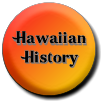HAWAIIAN
FOLKLORE
FOLKLORE
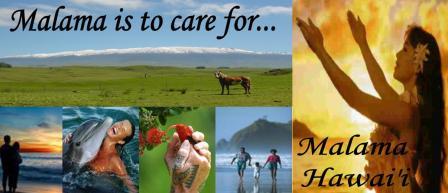

Are the Hawaiian islands part of the lost continent of Lemuria or MU?
Scroll down to learn more...
Scroll down to learn more...
Have you ever wondered why the Hawaiians share similarities in culture, language and beliefs with other South Pacific peoples?
The Polynesian South Pacific connection is probably due to, the proven fact, that the Polynesians were and are master seamen. They mastered sailing the open seas, at least one thousand years before white man would leave the sight of land. For centuries the Polynesians migrated throughout the Pacific Ocean sharing their beliefs, culture, customs and language. I believed the similarities between Polynesians was due to their sea faring abilites, until I came across the story of Mu.
Most people have heard of the lost continent of Atlantis, but few have heard of the lost continent of Mu or Lemuria. ALF first heard about Mu from a Cherokee Native American. She cited a story about Turtle Island (what she called North America) the motherland of Mu and how her people had traveled away from the motherland before it sank. She also told me of a scientist, Col. James Churchward, of the 1930's; who studied ancient writings of the ancient people of North and South America. His studies eventually took him to India and China and he again noticed similarities between the ancient writings despite the vast Pacific Ocean as a barrier. He then surmised from his studies that there had to be an ancient continent in the Pacific Ocean.
The Polynesian South Pacific connection is probably due to, the proven fact, that the Polynesians were and are master seamen. They mastered sailing the open seas, at least one thousand years before white man would leave the sight of land. For centuries the Polynesians migrated throughout the Pacific Ocean sharing their beliefs, culture, customs and language. I believed the similarities between Polynesians was due to their sea faring abilites, until I came across the story of Mu.
Most people have heard of the lost continent of Atlantis, but few have heard of the lost continent of Mu or Lemuria. ALF first heard about Mu from a Cherokee Native American. She cited a story about Turtle Island (what she called North America) the motherland of Mu and how her people had traveled away from the motherland before it sank. She also told me of a scientist, Col. James Churchward, of the 1930's; who studied ancient writings of the ancient people of North and South America. His studies eventually took him to India and China and he again noticed similarities between the ancient writings despite the vast Pacific Ocean as a barrier. He then surmised from his studies that there had to be an ancient continent in the Pacific Ocean.
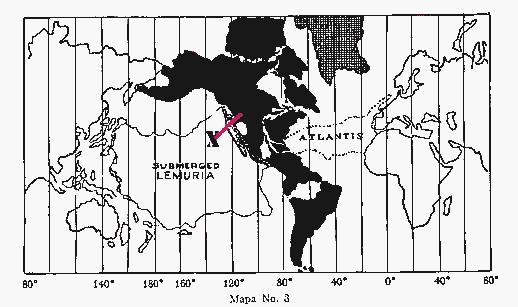
This map shows the lost continents of Atlantis and Lemuria. The "X" in picture of Lemuria shows the approximate location of three submerged pyramids. Read more below...
A few months later I met a Hawaiian elder or Kupuna educator-historian. He talked about Mu and the ancient people of Mu or Lemuria. These ancient people lived in harmony with everything around them, he said, living by principles of positive loving creative thought. They knew the power thought and that it would not enter the mind of a Lemurian to have a negative thought or partake in a negative action or deed. The people of Mu knew what was going to happen to their precious motherland and many migrated to the corners of the earth. The Kapuna also stated that his Hawaiian family genealogy is linked with the ancient people of Mu. Then he invited me to his office were we "googled" Pacific Pyramids. These are the maps he showed me...
This satellite picture shows the location of the Pacific Pyramids, which appears to have energy radiating from the location .
The Hawaiian islands on the lower left side of picture and the pyramids midway between the islands and the west coast of North America.

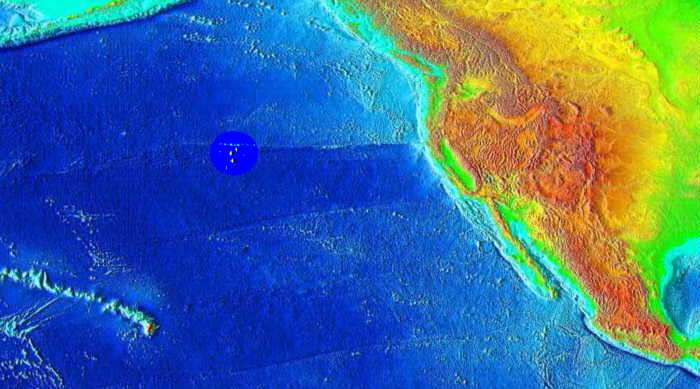
I was surprised at what he showed me, but none the less, made me a believer in the lost continent of Mu. Half way between North America and the Hawaiian Islands there are three pyramids under about 2600 feet of water that are the in the same shape and form of the great pyramids of Giza. See the close-up satellite pictures below...
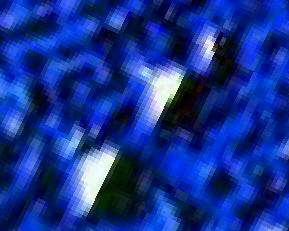
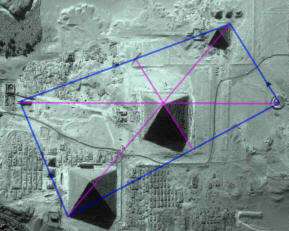
Pacific Pyramids
Pyramids of Giza
LEMURIAN PARADISE
According to author James Churchward, MU was about 5,000 miles long and 3,000 miles wide, a beautiful tropical paradise like the Garden of Eden. He claims there were 64 million people who died in the sinking, and that it dated back over 50,000 years. The Pacific Islands are the remaining mountain peaks of the lost continent. Precise detailed maps of the lost continent of Mu and Atlantis were found on stone tablets from Pre-Inca Ica, Peru, by Dr. Javier Cabrera, engraved in stone and photographed by Robbert Charroux.
United Nations diplomat Farida Iskoviet, assistant to United Nations President Adam Malik, came to Maui in 1972 and researched Lemurian ruins and history and concluded that they were real.
One of Hawaii 's leading authorities on Lemurian research was Sgt. Williard Wannall from Army Intelligence in Oahu . He reported that ruins of a submerged Lemurian city was between Maui and Oahu . It was a Top Secret project in Naval Intelligence in 1972.
~~~~~~~








~~~~~~~
Lemuria, the Lost Continent of Mu, Pele the Volcano Goddess, Ohia Lehua and Pele- A Hawaiian Love Story.
"Pele" the Volcano Goddess
In Hawaiian mythology Pele (pronounced PAY-lay in English) is the goddess of fire, lightning, dance, volcanoes and violence. She is a daughter of Haumea and Kane Milohai, and her home is believed to be the fire pit, Halema'uma'u crater, at the summit caldera of Kilauea, one of the Earth's most and continuously active volcanoes; but her domain encompasses all volcanic activity on the Big Island of Hawai'i. In the book of night of the howling dogs.
There are several traditional legends associated with Pele in Hawaiian mythology:
Expulsion version
Pele is born to Kane-hoa-lani and Haumea in Kuaihelani. She sticks so close to Lono-makua, the fire god, as to cause a conflagration (or, as in the Aukelenuiaiku story, makes love to her sister's husband) and her older sister Na maka o Kaha'i, called "a sea goddess," drives her away. She takes passage in the canoe Honua-i-a-kea with her little sister carried in her armpit and accompanied by her brothers Ka-moho-ali"i, Kane-milo-hai, Kane-apua, and others, and arrives at the Hawaiian group by way of the northwestern shoals. There Kane-milo-hai is left on one islet as an outguard and Kane-apua on another, but Pele pities this last younger brother and picks him up again. A group of songs relate the relentless pursuit of the party by the older sister until the two sisters encounter each other in Kahiki-nui on the island of Maui and Pele's body is torn apart and the fragments heaped up to form the hill called Ka-iwi-o-Pele (The bones of Pele) near Kauiki, while her spirit takes flight to the island of Hawaii and finds a permanent home on Hawaii.
Flood version
Pele is born in Kapakuela, a land to the southwest, "close to the clouds," and her parents are Kane-hoa-lani and Ka-hina-li"i, her brothers Ka-moho-ali"i and Kahuila-o-ka-lani. By her husband Wahieloa (Wahialoa) she has a daughter Laka and a son named Menehune. Pele-kumu-honua entices her husband from her and Pele travels in search of him. With her comes the sea, which pours from her head over the land of Kanaloa (Kahoolawe), never before so inundated, and her brothers chant,
"A sea! a sea!
Forth bursts the sea,
Bursts forth over Kanaloa (Kahoolawe),
The sea rises to the hills. . . ."
"Thrice" (according to the chant) the sea
floods the land, then recedes. These floodings
are called The-sea-of-Ka-hina-li"i.
~~~~~~~
There are several traditional legends associated with Pele in Hawaiian mythology:
Expulsion version
Pele is born to Kane-hoa-lani and Haumea in Kuaihelani. She sticks so close to Lono-makua, the fire god, as to cause a conflagration (or, as in the Aukelenuiaiku story, makes love to her sister's husband) and her older sister Na maka o Kaha'i, called "a sea goddess," drives her away. She takes passage in the canoe Honua-i-a-kea with her little sister carried in her armpit and accompanied by her brothers Ka-moho-ali"i, Kane-milo-hai, Kane-apua, and others, and arrives at the Hawaiian group by way of the northwestern shoals. There Kane-milo-hai is left on one islet as an outguard and Kane-apua on another, but Pele pities this last younger brother and picks him up again. A group of songs relate the relentless pursuit of the party by the older sister until the two sisters encounter each other in Kahiki-nui on the island of Maui and Pele's body is torn apart and the fragments heaped up to form the hill called Ka-iwi-o-Pele (The bones of Pele) near Kauiki, while her spirit takes flight to the island of Hawaii and finds a permanent home on Hawaii.
Flood version
Pele is born in Kapakuela, a land to the southwest, "close to the clouds," and her parents are Kane-hoa-lani and Ka-hina-li"i, her brothers Ka-moho-ali"i and Kahuila-o-ka-lani. By her husband Wahieloa (Wahialoa) she has a daughter Laka and a son named Menehune. Pele-kumu-honua entices her husband from her and Pele travels in search of him. With her comes the sea, which pours from her head over the land of Kanaloa (Kahoolawe), never before so inundated, and her brothers chant,
"A sea! a sea!
Forth bursts the sea,
Bursts forth over Kanaloa (Kahoolawe),
The sea rises to the hills. . . ."
"Thrice" (according to the chant) the sea
floods the land, then recedes. These floodings
are called The-sea-of-Ka-hina-li"i.
~~~~~~~
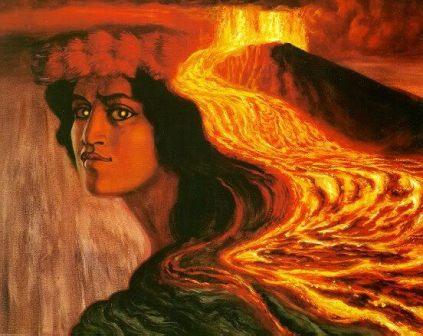
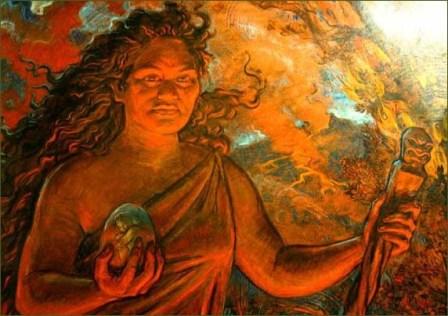
The Lost Continent of Mu
LEMURIA
LEMURIA




Hawai'i Volcano
Scenes by ALF
Scenes by ALF
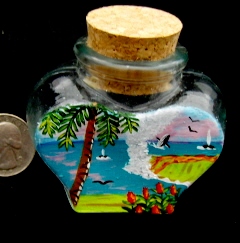
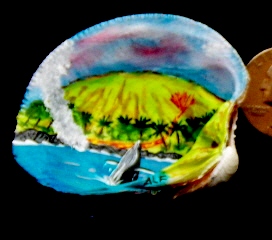
Ohia, Lehua and Goddess Pele
A Hawaiian Love Story
A Hawaiian Love Story

If you pick a red lehua
blossom they say it will rain...
A Hawaiian folklore story...
This story came from a Jack's Tours bus driver, Uncle Loren.
Once there was a handsome man named 'Ohi'a. 'Ohi'a met a beautiful lady named Lehua, they were boyfriend and girlfriend. One day 'Ohi'a passed by Pele the goddess of fire. Pele immediately fell in love with him so she said, "I like you, be my boyfriend," but 'Ohi'a told Pele that he had already had a girlfriend named Lehua. Pele was mad that he wasn't her boyfriend, so she set a spell on him and turned him into an ugly tree.
When Lehua found out about this, she begged Pele to turn him back into human form again, but Pele didn't turn him back so Lehua went to the gods and asked them if they could turn 'Ohi'a back into human form but the gods said that they couldn't turn him back. Instead, they turned Lehua into a beautiful red flower and put her on the ugly tree that was 'Ohi'a so they could be together.
Today according to legend, when you pick a lehua blossom it will rain, because you are separating 'Ohi'a and Lehua.
You can find the 'Ohi'a Lehua in the mountains (MAUKA). The 'Ohi'a Lehua looks like a fluffy red flower on a really crooked, twisted tree. They also say that when Hawaiians work with the fragile lehua blossom, they always scrape a little of the bark so as to keep true love together.
~~~~~~~
blossom they say it will rain...
A Hawaiian folklore story...
This story came from a Jack's Tours bus driver, Uncle Loren.
Once there was a handsome man named 'Ohi'a. 'Ohi'a met a beautiful lady named Lehua, they were boyfriend and girlfriend. One day 'Ohi'a passed by Pele the goddess of fire. Pele immediately fell in love with him so she said, "I like you, be my boyfriend," but 'Ohi'a told Pele that he had already had a girlfriend named Lehua. Pele was mad that he wasn't her boyfriend, so she set a spell on him and turned him into an ugly tree.
When Lehua found out about this, she begged Pele to turn him back into human form again, but Pele didn't turn him back so Lehua went to the gods and asked them if they could turn 'Ohi'a back into human form but the gods said that they couldn't turn him back. Instead, they turned Lehua into a beautiful red flower and put her on the ugly tree that was 'Ohi'a so they could be together.
Today according to legend, when you pick a lehua blossom it will rain, because you are separating 'Ohi'a and Lehua.
You can find the 'Ohi'a Lehua in the mountains (MAUKA). The 'Ohi'a Lehua looks like a fluffy red flower on a really crooked, twisted tree. They also say that when Hawaiians work with the fragile lehua blossom, they always scrape a little of the bark so as to keep true love together.
~~~~~~~
Kahu O Kahiko Inc. a non-profit organization was founded in 1996. Its purpose is to collect, preserve, and protect Hawaiian historical information. Our intent is to share the knowledge and educate others interested in the future of Hawai'i, through the preservation of Hawaiian cultural traditions and by the saving of sacred landmarks by promoting, restoring, and protecting the fragile ecosystem of Hawaii; while also endorsing healthy food, eco-friendly affordable living and life style habits.


